Homemade Keto Buns (Fluffy & Chewy)
The texture of these pillowy soft, fluffy and perfectly chewy Homemade Keto Buns are so close to the the real thing, you won’t believe it! If you’ve been missing buns on Keto, these are a game-changer.
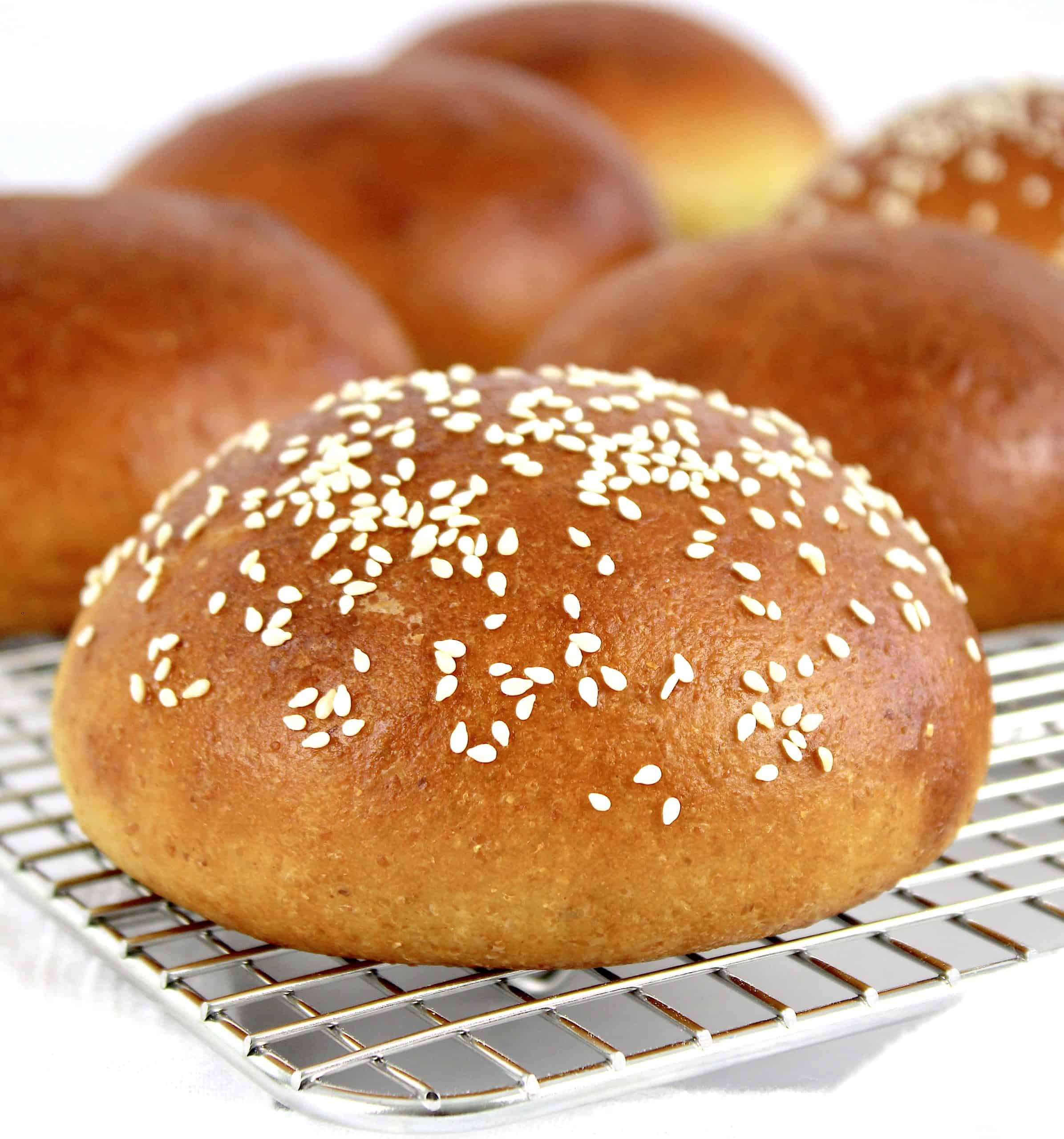
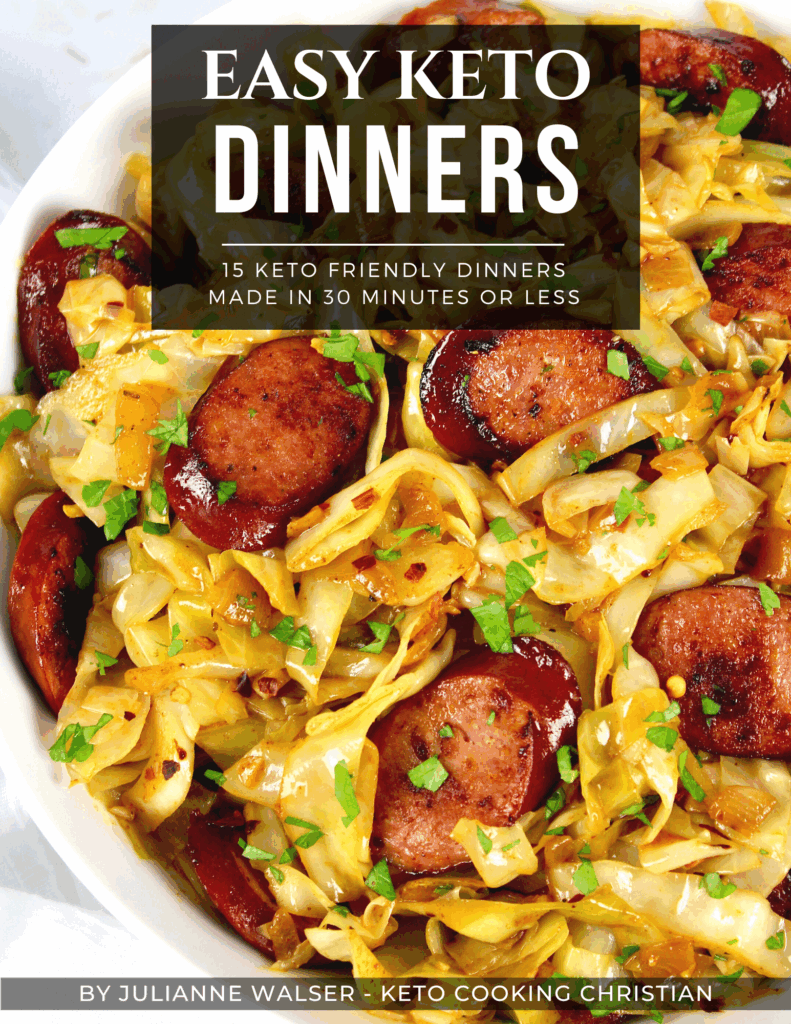

Download FREE COPY OF
Easy Keto Dinners eBook
15 Easy Keto friendly dinners made in 30 minutes or less!
❤️ Why You’ll Love these Keto Buns
- Light and fluffy
- Nice chewy texture, much like traditional buns
- Easy to follow step by step instructions
- Better than store bought buns
- Only 3 net carbs each!
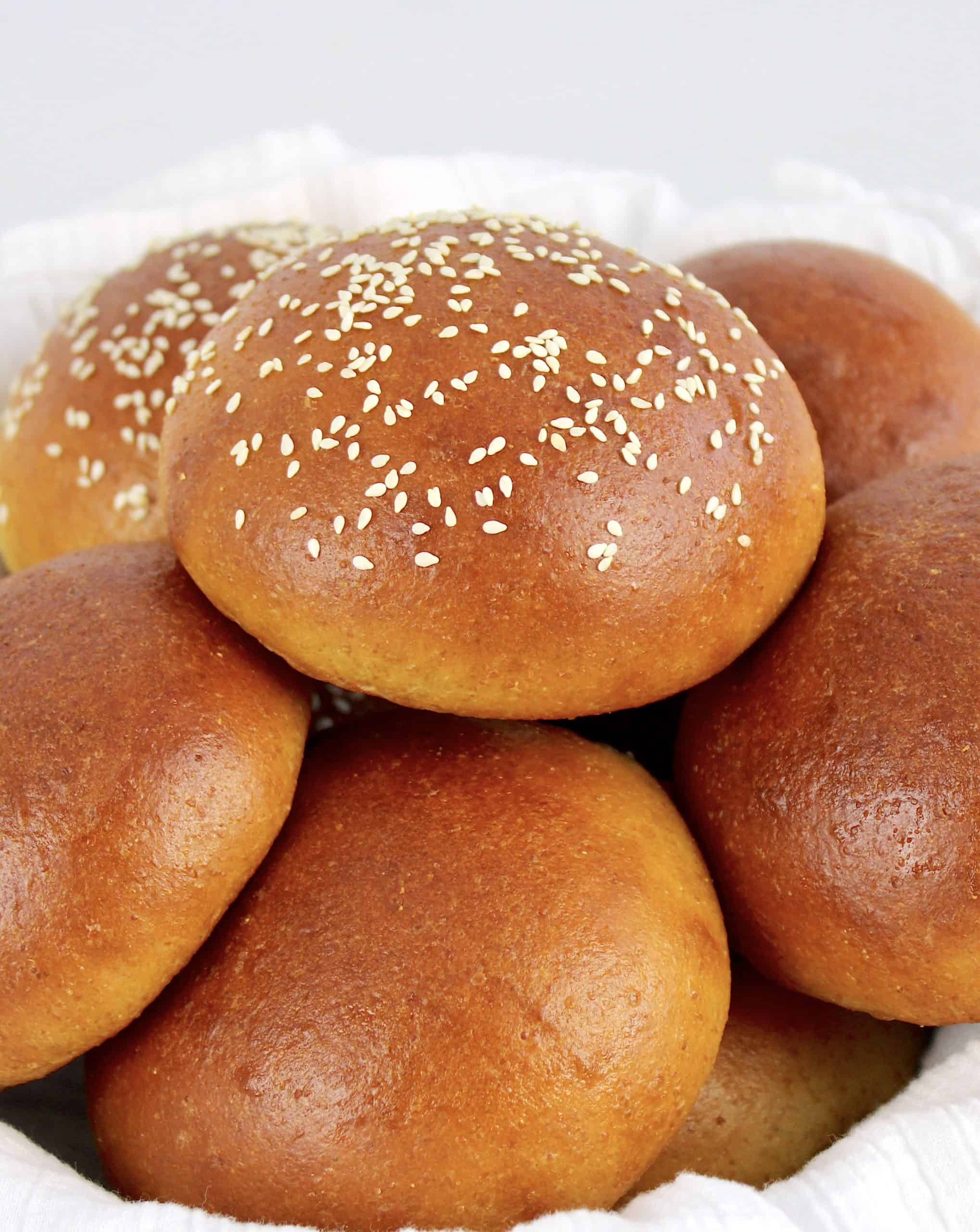
This recipe uses a lot of the same ingredients in my Homemade Keto Bread, which was initially inspired by Diedre’s Kitchen on YouTube, who made a wonderfully creative Keto bread loaf several years ago.
If you’re on Keto, then there’s a good chance some of the things you may be miss the most are breads and buns. That was certainly the case for me! But, if making your own buns seems a bit daunting, with this recipe, you’ll have no worries! I promise if you follow the instructions, you’ll be absolutely thrilled with the way they taste and their glorious texture!
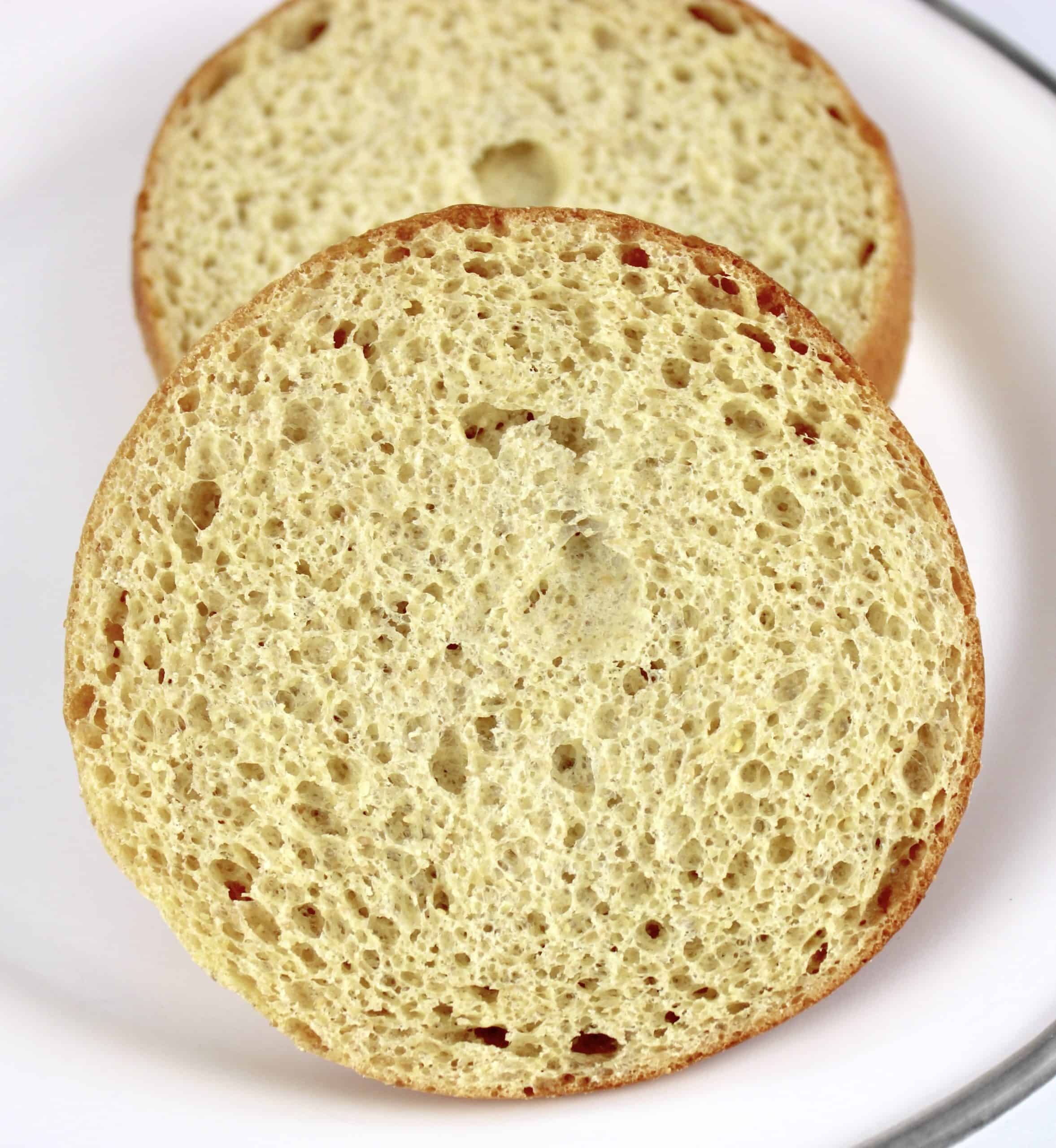
Nothing beats a good old fashion hamburger, egg salad sandwich or BLT. But if you just get turned off with those eggy-tasting Keto bun recipes, you are truly going to fall in love with this recipe. There are a few key secret ingredients I used to get them just right, so read on to find out how to make them yourself! 😉
🛒 What You’ll Need to make Keto Buns
- Vital wheat gluten
- Oat fiber
- Lupin flour
- Ground golden flax seed
- Warm water
- Eggs
- Monk fruit/allulose
- Butter
- Active dry yeast
- Baking powder
- Inulin powder
- Salt
*Exact measurements are listed in the recipe card below.
🥣 Recommended Tools
🔪 How to Make Keto Buns
Add the warm water and inulin into a mixing cup, then sprinkle the yeast over the top. Quickly mix for a few seconds, then allow the yeast to bloom while you mix up your dry ingredients.
Tip: If you don’t have inulin, you can use honey instead. Whether you use inulin or honey, the carbs won’t affect you, since the yeast feeds off the sugar to emit carbon dioxide, which makes the bread light and airy.
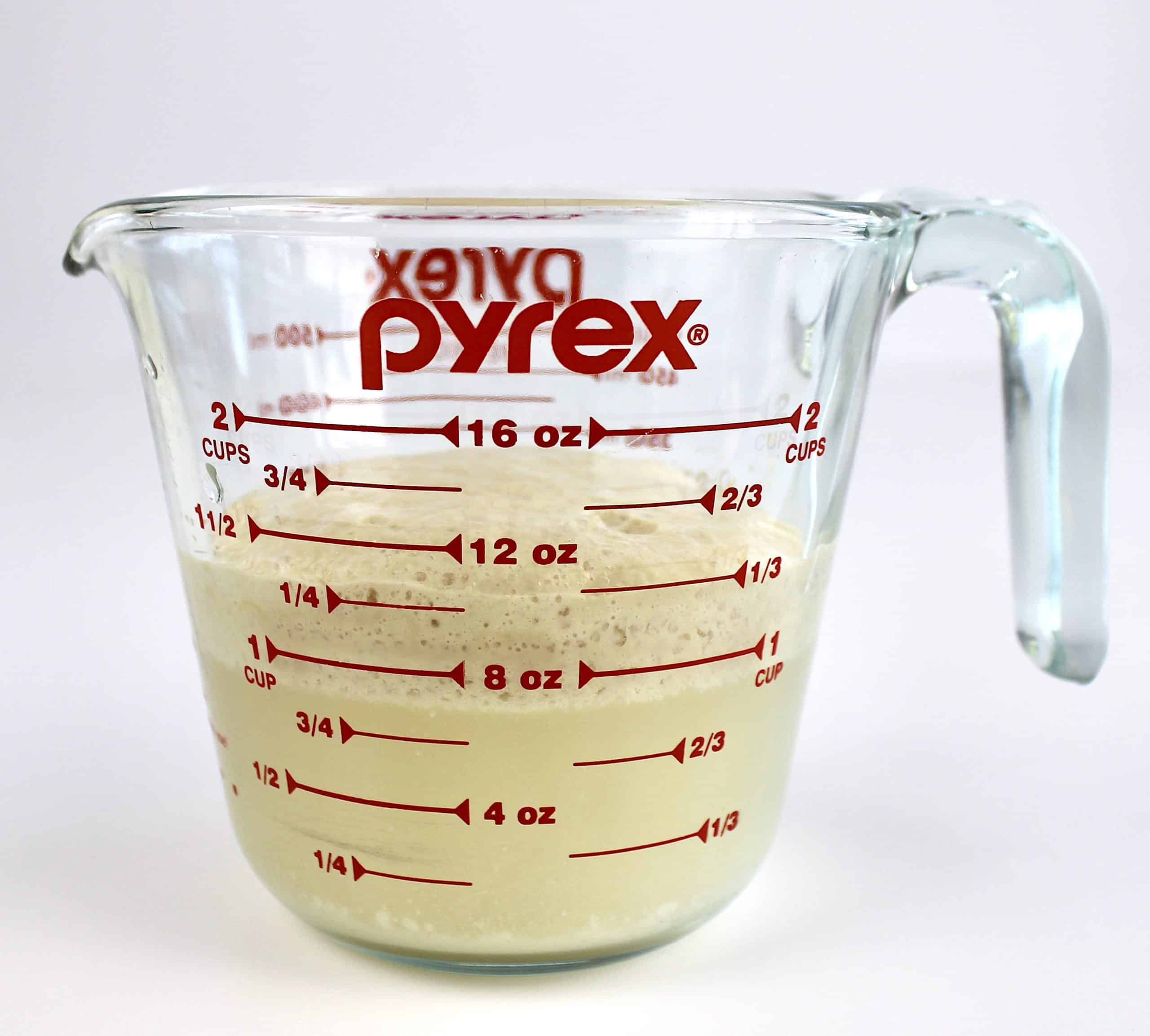
Tip: You should be able to smell your yeast and if your yeast doesn’t foam up, it’s likely expired. It’s best to use an instant read thermometer to make sure the temperature of your water is 125°F. If it’s too cold, the yeast won’t activate. If it’s too hot, it will kill the yeast.
In the bowl of a stand mixer, add in the vital wheat gluten, oat fiber, lupin flour, golden flaxseed, sweetener, salt and baking powder.
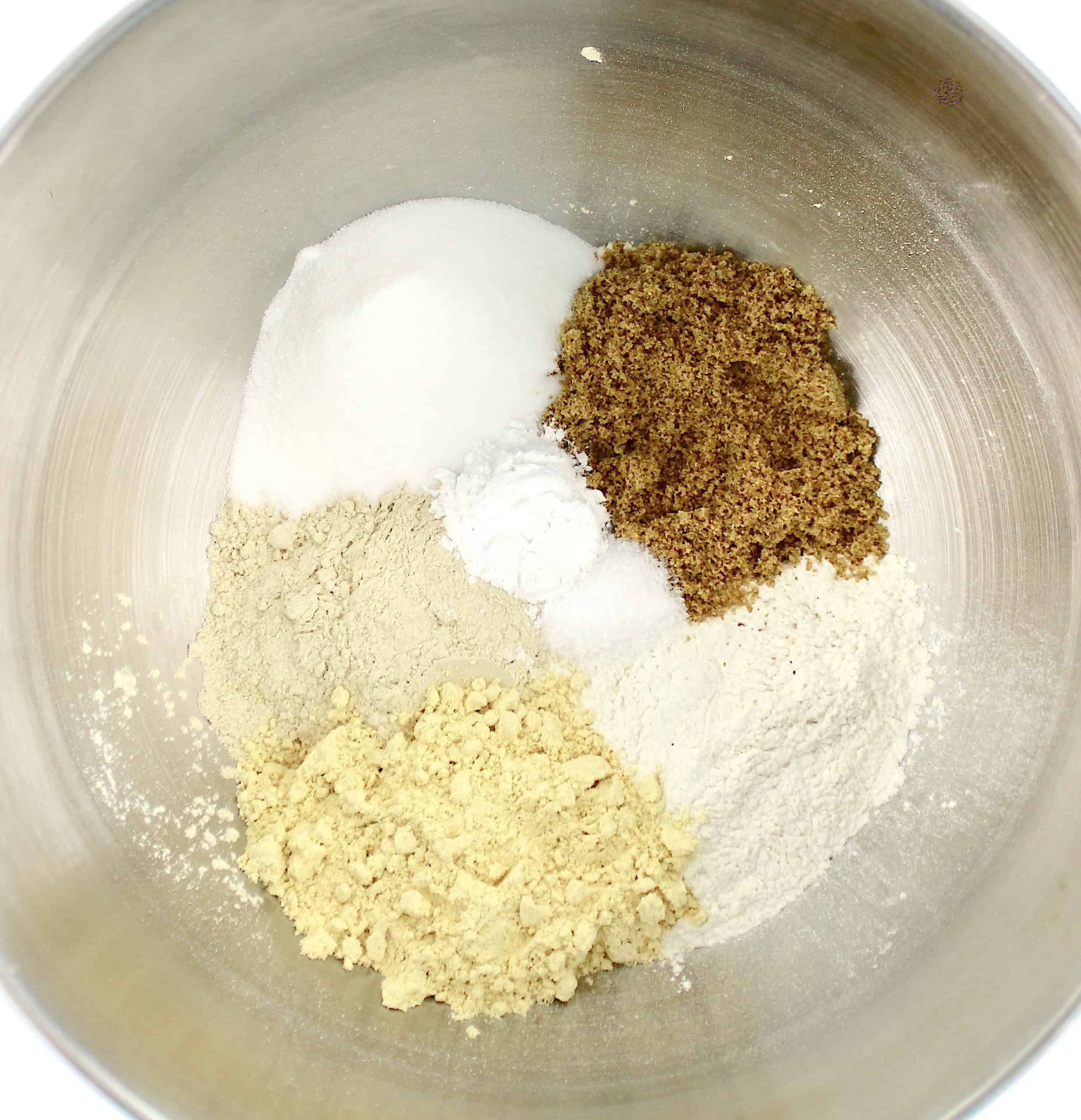
Whisk to combine, break up any lumps and make it light and fluffy.
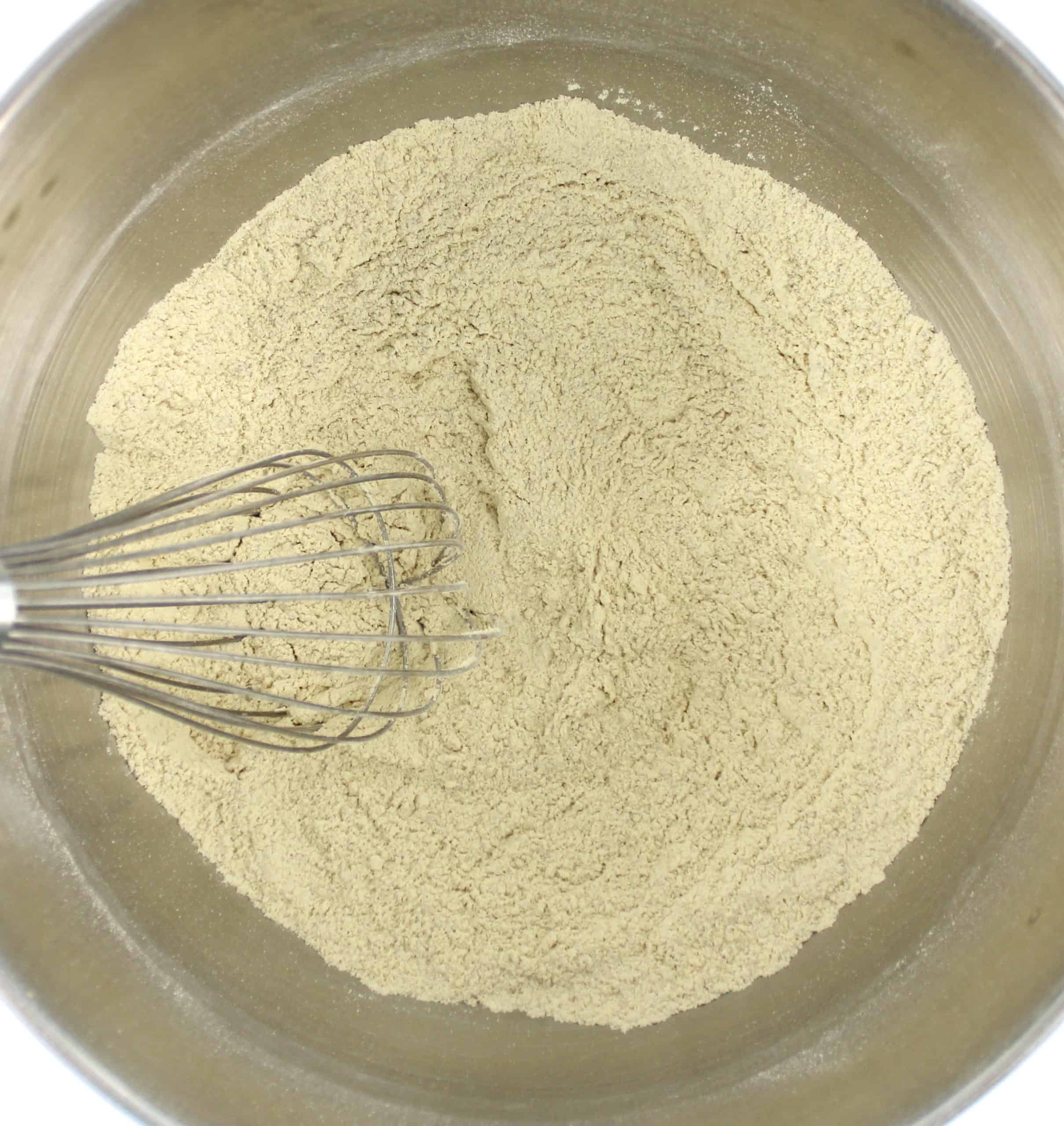
Once the yeast has bloomed (takes about 5-7 minutes), slowly pour it into mixer as it’s running.

Then pour in the beaten eggs, until the dough comes together.
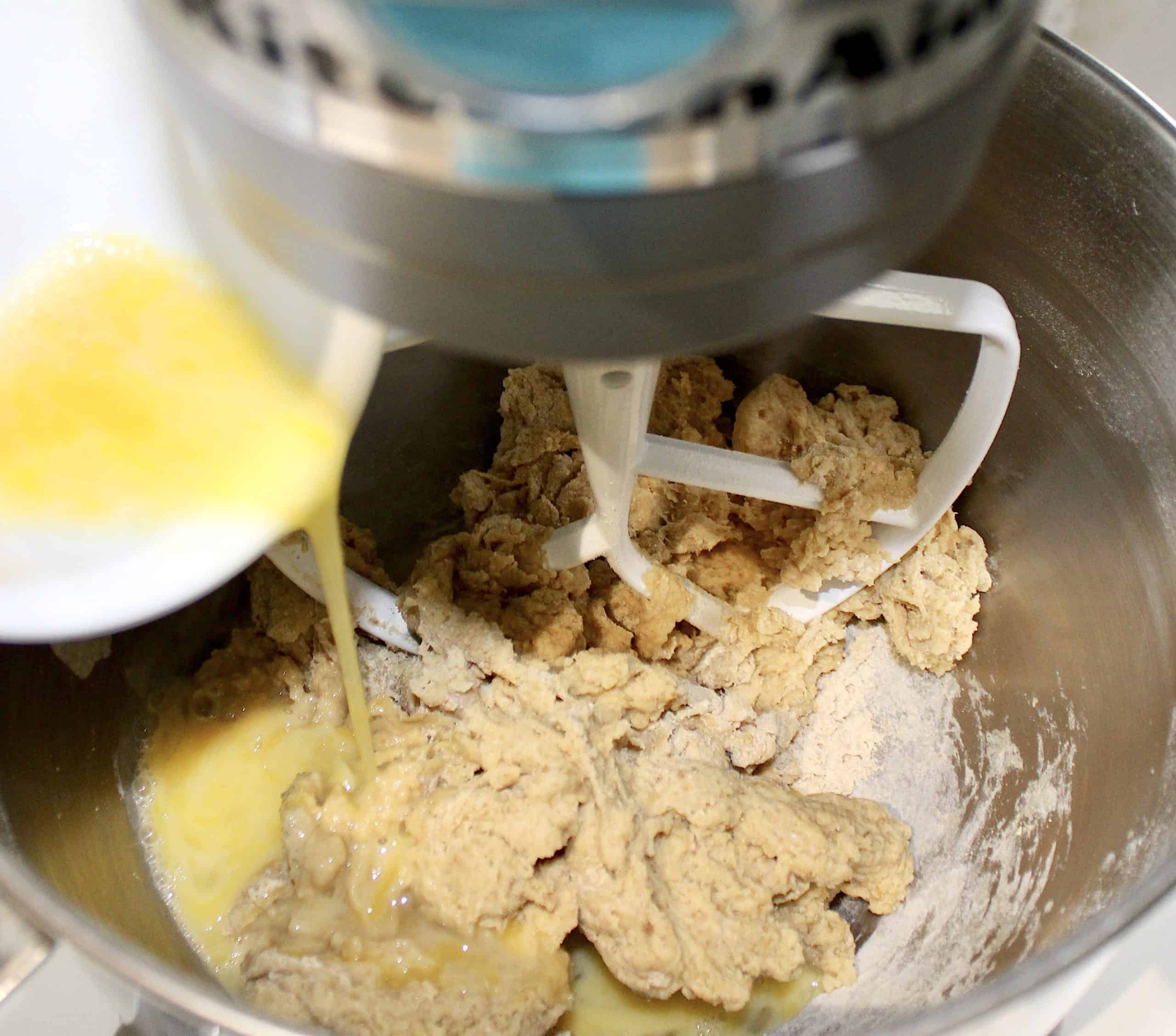
Add in the butter and continue mixing, just until combined. If the dough is too sticky, sprinkle in 1-2 tablespoons of golden flaxseed, starting with just 1 tablespoon. It should be a little tacky, but not very sticky and the sides of the bowl should be fairly clean.

Scrape down the sides, remove the paddle, then replace with a dough hook. Allow the dough to knead for 7 minutes. Let the dough rest for 10 minutes.
Tip: I use this time to clean up a little and prepare my pan.

Once the dough has rested, turn it out onto your board, I use my Silpat because it doesn’t slide around. Cut the dough into 8 portions, and I prefer to weigh them, so I know they’re all around the same size and will cook at the same time.
Tip: Resting the dough makes it easier to form the buns. Otherwise the dough will be very elastic and could keep springing back, instead of taking on the shape you’re wanting.
Take each piece and flatten it out slightly, then pull all the edges into the center, creating a ball. Pinch all the seams together and turn over.
Cupping your hand over the top, roll the dough in a circular motion until the seam has closed and is no longer showing.
Place the buns back on a baking sheet lined with parchment paper, then sprayed with nonstick spray or olive oil.
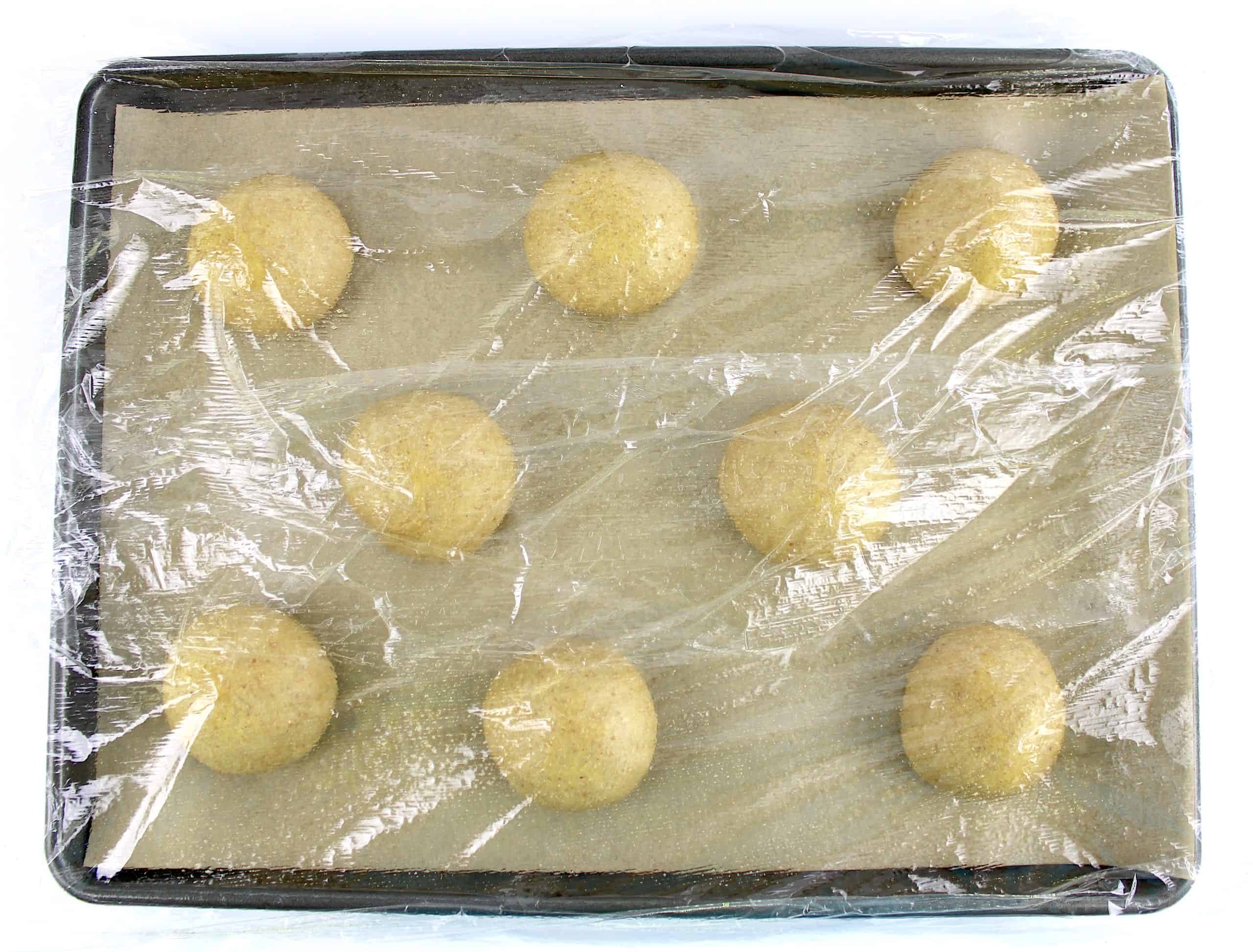
Spray a piece of plastic wrap with nonstick spray and gently place on top of the buns, don’t tuck in the ends or wrap it tight. You want to give it plenty of room to expand.
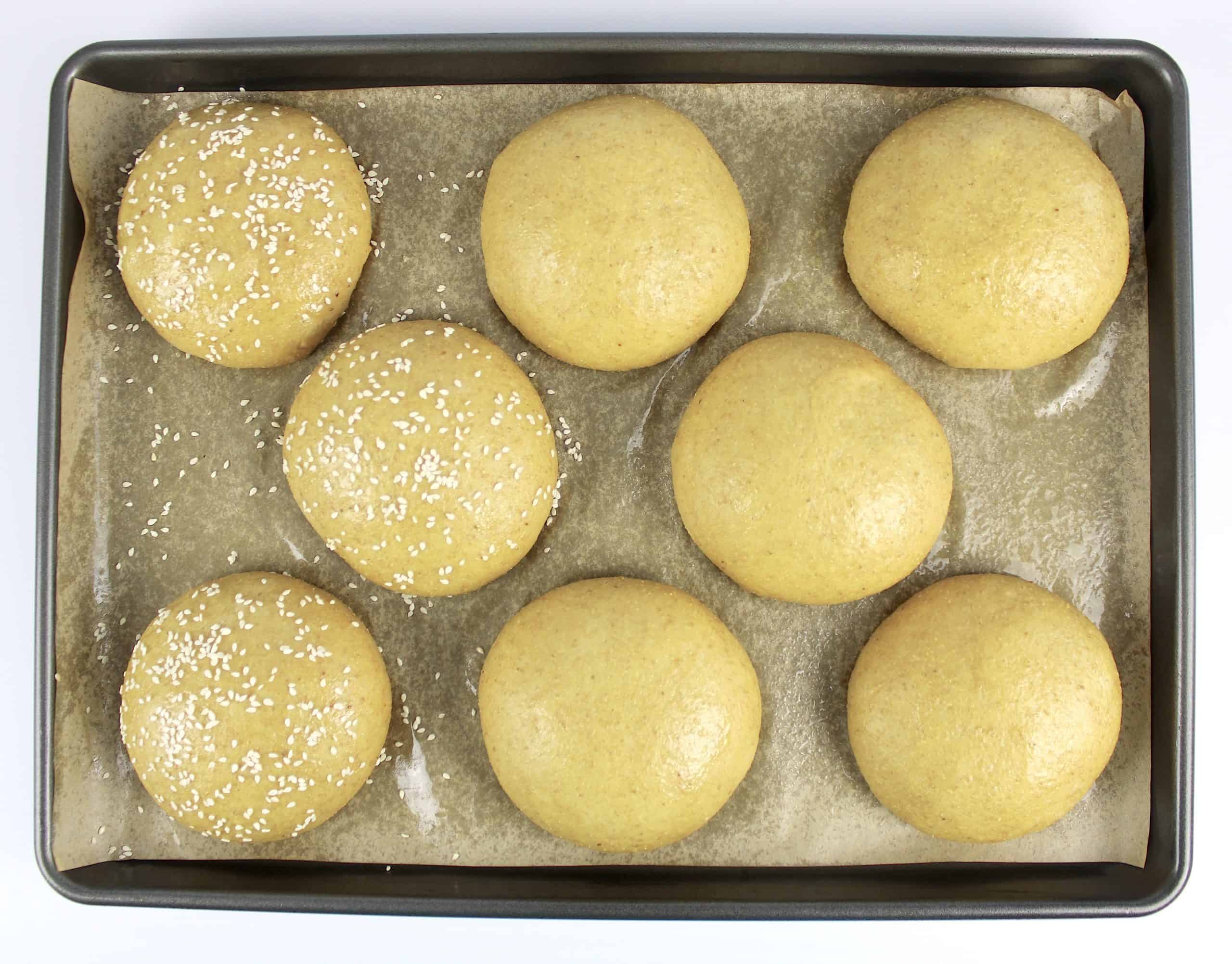
Using the bread proof setting in your oven, allow to proof for 2 hours. To help create the perfectly warm moist environment, place a shallow pan with boiling water on the bottom of your oven.
Tip: If your oven doesn’t have a bread proof setting, you can place a microwave safe dish or glass with hot water in the microwave, along with the rolls to proof in there.
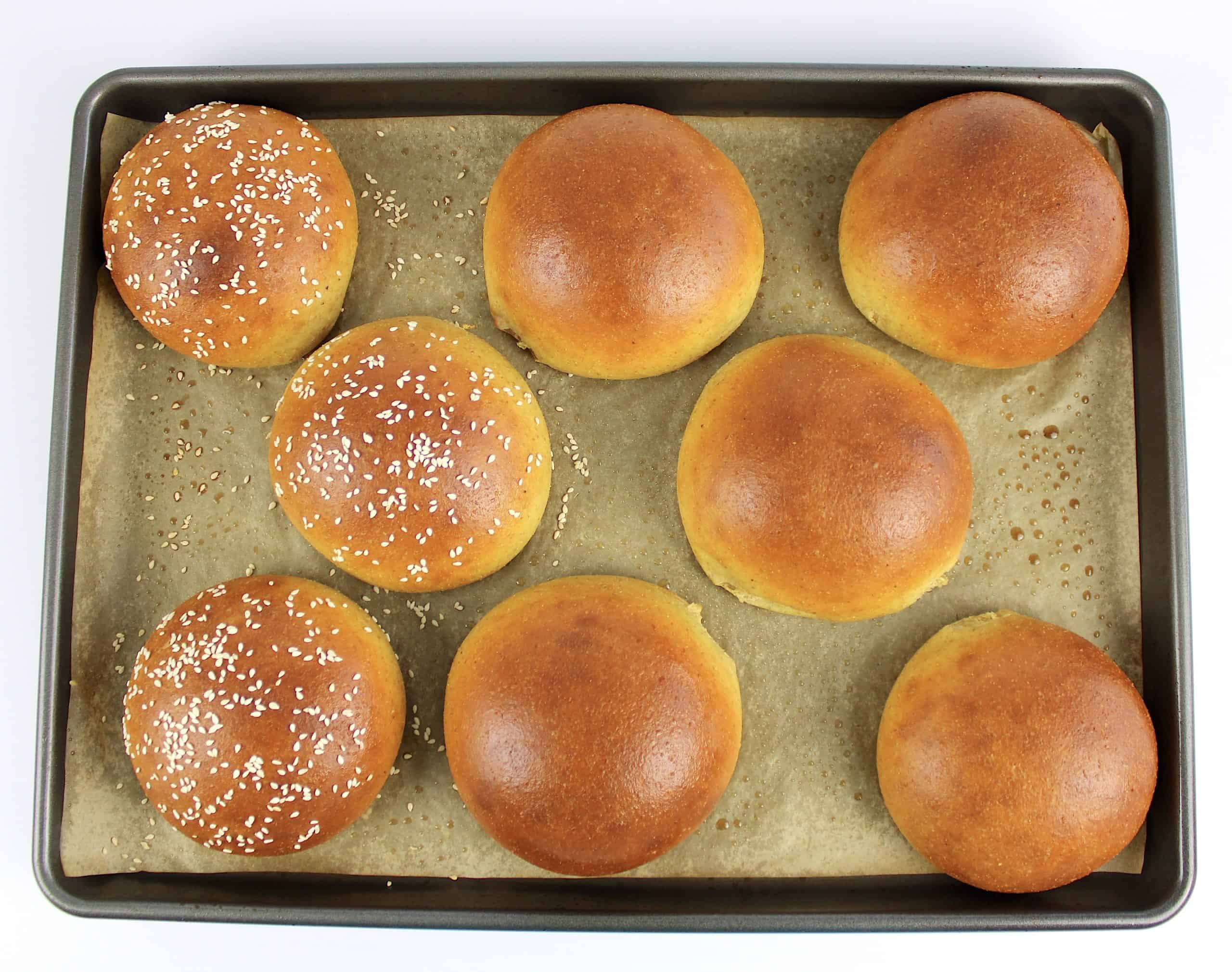
Preheat oven to 350°F. Remove the plastic wrap and bake the buns 18-20 minutes or until golden brown and cooked through.
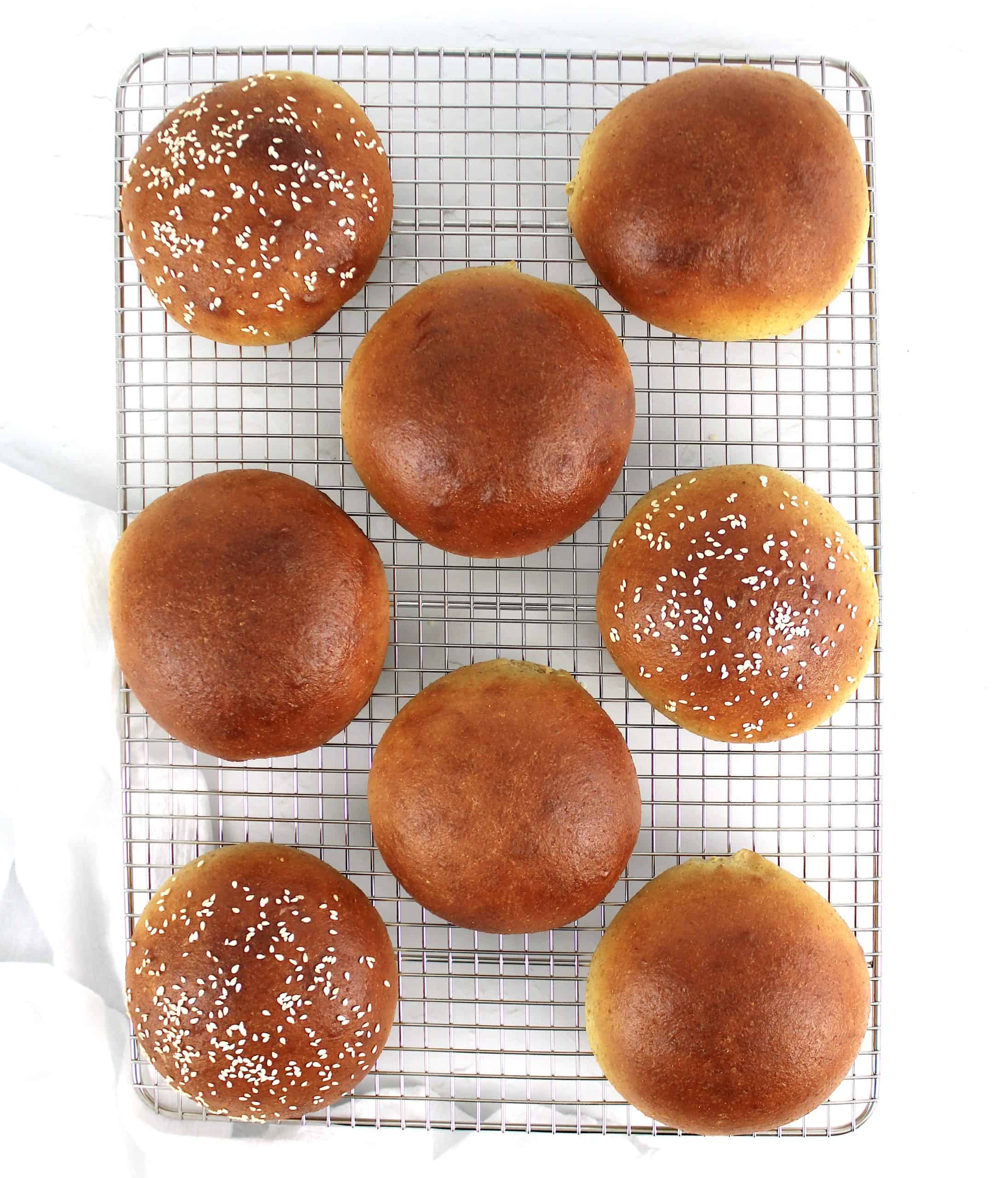
Allow the buns to cool on a cooling rack before serving. Store leftovers at room temperature for 1-2 days, then store in the fridge in an airtight container for 3-4 days.
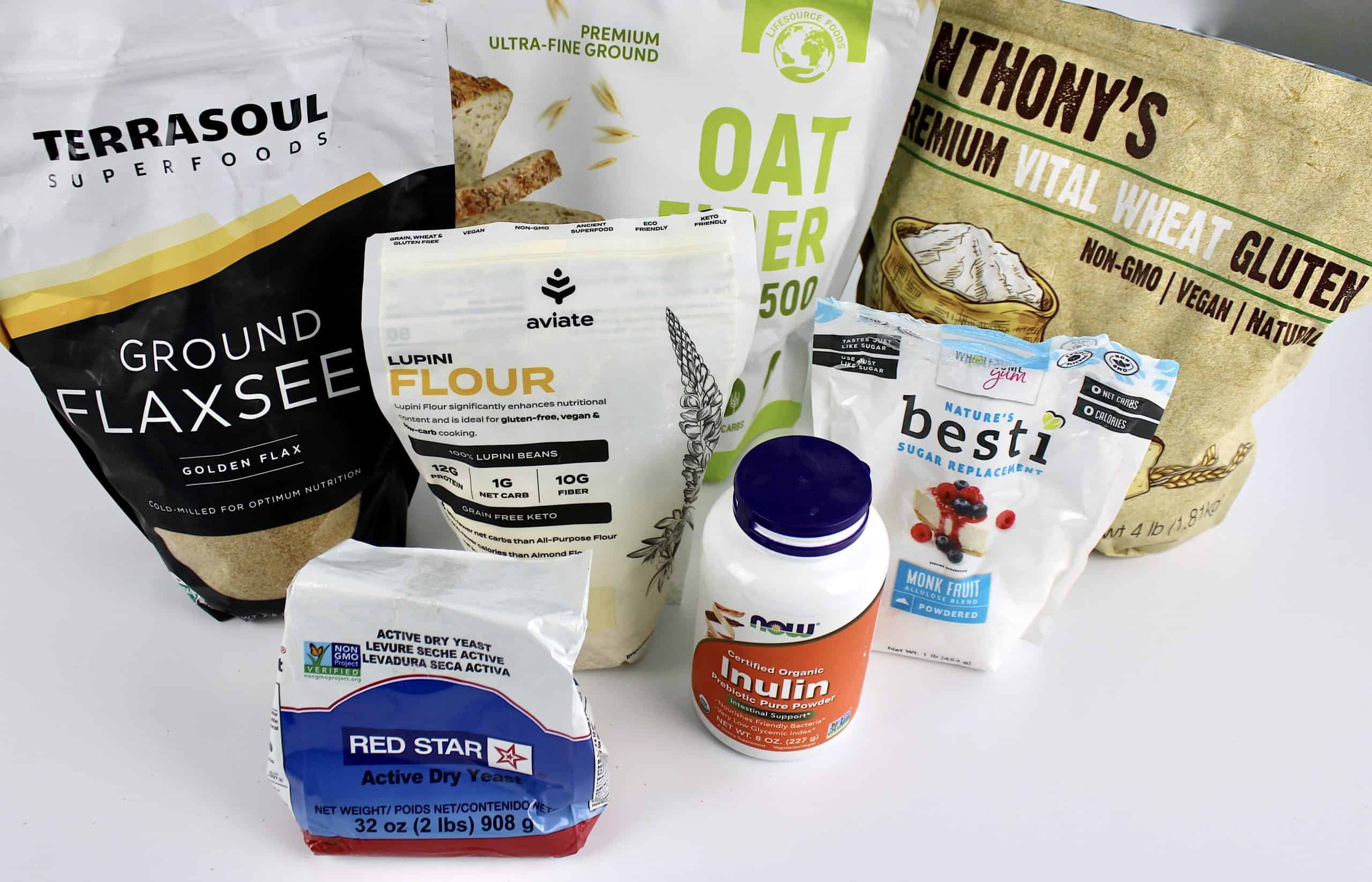
What Key Ingredients Are Used in Keto Buns?
Some of the ingredients I’ve used might be a little unfamiliar, while others you’ve likely seen me bake with before. They’re all Keto friendly and I’ve personally tested my ketones a number of times, just to be absolutely sure and it has never once kicked me out of ketosis or even stalled my weight loss.
As with any new product you have never tried using before, you should test it for yourself using a keto blood meter, if you’re at all concerned. The best way to test is to check your ketone level 2-3 hours after eating.
These are the exact ingredients and brands that I use, and yes brands matter in most of these ingredients. I opt for ones that give me the best texture and mildest flavor:
Vital Wheat Gluten
This is ingredient seems to cause some confusion, so maybe this will explain things. Gluten is a protein that is found in wheat but with Vital Wheat Gluten, water is added to the wheat to hydrate it.
This activates the gluten. Once the gluten has been activated, all other parts of the wheat are removed so just the protein is left behind which is what makes it suitable for Keto diets.
Note: If you are sensitive to gluten, please know that even though this product is Keto friendly, it does contain gluten.
Oat Fiber
Oat Fiber is made from grinding the outer husks of oats. How healthy is oat fiber? It’s pure insoluble fiber, which doesn’t dissolve in water and isn’t broken down in the digestive tract, so it has zero net carbs and is perfect for a Keto Diet. It helps give a more traditional texture and that’s why I use it so often. Check out all the Keto Oat Fiber Recipes you can make!
Lupin Flour
You may have never heard of lupin flour before. Just don’t let the word “flour” scare you. Lupin flour is made from the lupin beans which are closely related to peanuts.
Even though lupin beans are indeed legumes, they are devoid of starch and high in protein and fiber, which makes it a great low carb baking ingredient. Aviate Foods makes the best Lupin Flour I’ve found, you can order it on Amazon with code: KETOCC20 to save 20%!
Ground Golden Flaxseed
Flaxseeds are derived from the flax plant, also called Linum usitatissimum. Sound a little too scientific? The most important thing to remember about golden flaxseed is, it consists of 29% of carbohydrates with 95% of that coming from fiber.
Their high soluble fiber content is perfect for Keto baking when maintaining a state of ketosis is important to you.
Active Dry Yeast
Dry active yeast is what gives these buns a lift and makes texture most like traditional bread. The great news is, for an entire tablespoon, there are only 5 grams of carbs with 3 of those coming from fiber which makes the carb impact for an entire recipe very minimal.
Inulin
Inulin powder is made from the chicory root fiber and contains no net carbohydrates. It’s the perfect ingredient to enhance the flavor and texture of Keto, low-carb or gluten-free bread recipes.

Can I Freeze These Low Carb Buns?
Freshly made buns are always at their best within the first couple of days of being made. But if you’re in the baking mood and want to bake some in bulk, these three simple steps will make sure you’ll have some on hand when the craving hits:
- Allow them to cool: Always start with room temperature cool buns before wrapping them. If you don’t, the warmth from the buns will form condensation, which is what causes freezer burn.
- One at a time: It may seem a little redundant, but trust me, it pays off to wrap them individually. I recommend double wrapping them in plastic wrap, then for good measure, I slip the down in a freezer bag. Another benefit to doing them this way is they won’t stick together, plus you can take out ever how many you want at a time
- Date them: You can freeze these buns for about 3 months. The key is to get them into the freezer as soon as you can because they will only be as fresh thawed as they were when you froze them. Make sure to table the bag with the date you froze them!

Why Did My Rolls Come Out Flat?
If your buns came out flat, it’s usually because your yeast was expired. Yeast is much more perishable than other dry baking ingredients, so make sure you check the “best used by,” date on the package.
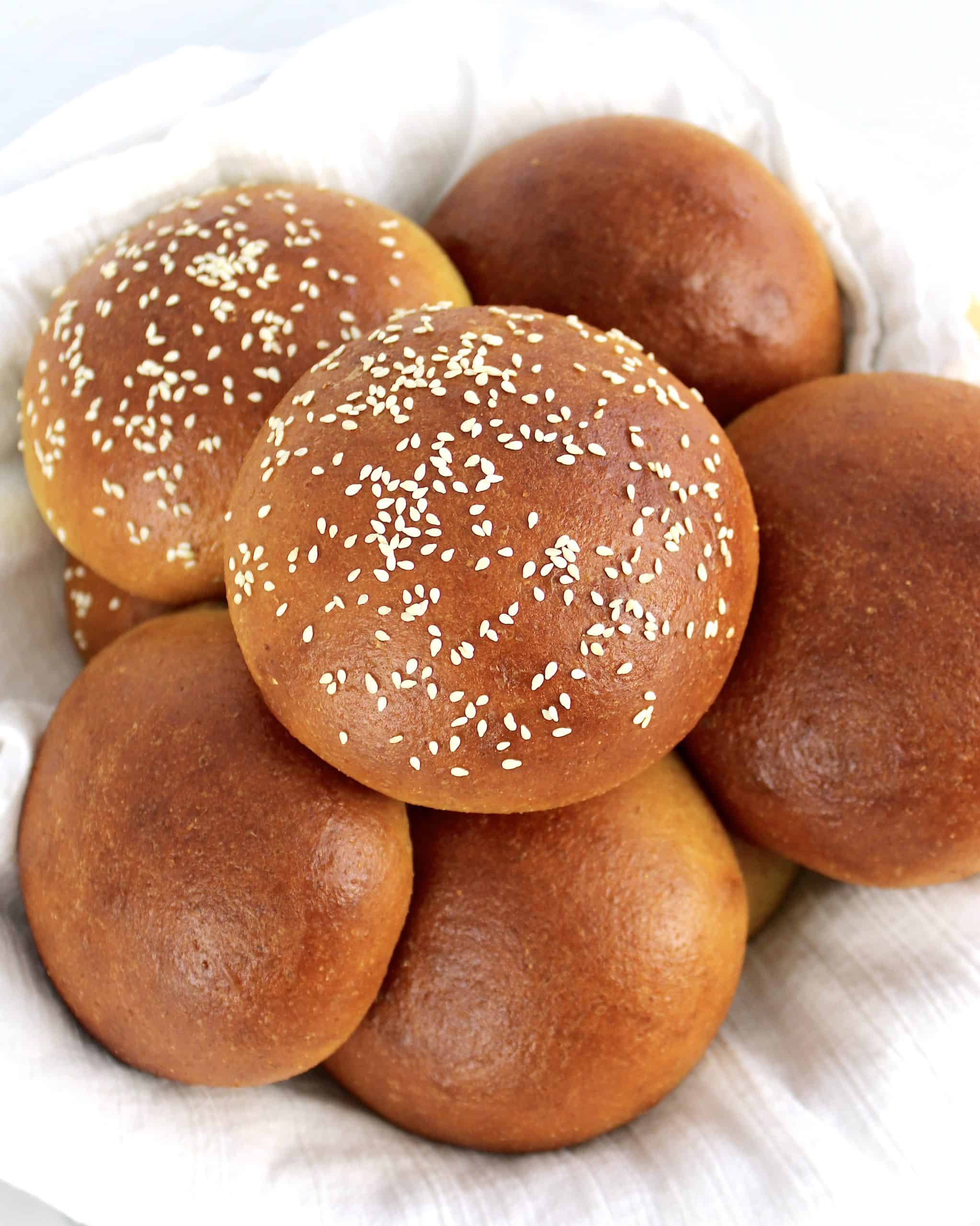
What Kind of Bread is Keto-Friendly?
There is really no hard and fast rule as to exactly what is and what isn’t considered a Keto bread. Though the ingredients used to make it is a good indicator as to if it is the best choice for your goals on Keto.
The ingredients in this recipe are all low carb and when eaten in moderation are perfectly acceptable for those on Keto, especially with each one only having 3 net carbs.
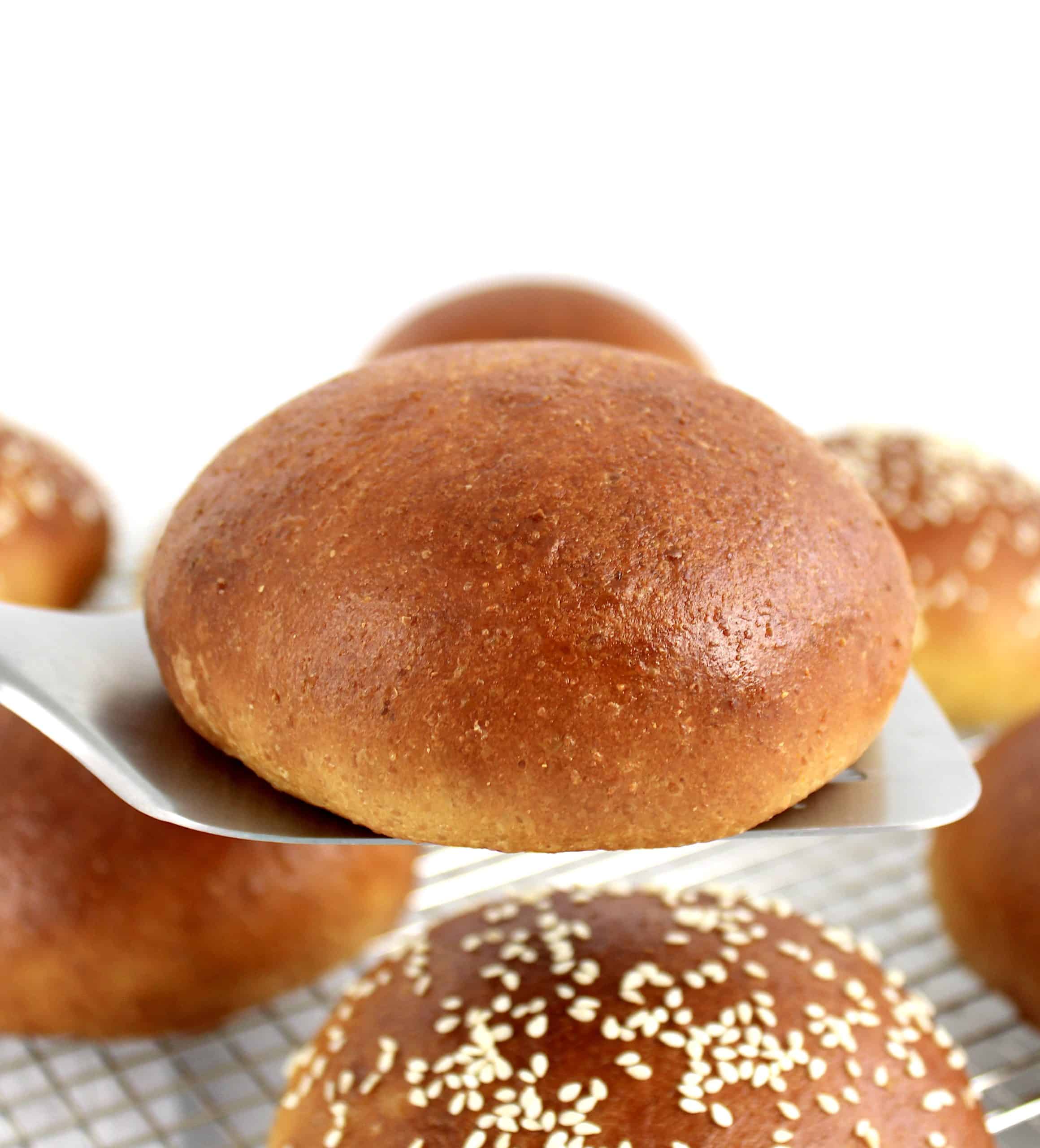
Why Are My Keto Buns Hollow?
Some store-bought Keto buns and even recipes for homemade buns are made using psyllium husks. This can cause the dough to be too heavy, causing large holes to form in the baked buns. These homemade buns will not have that problem.
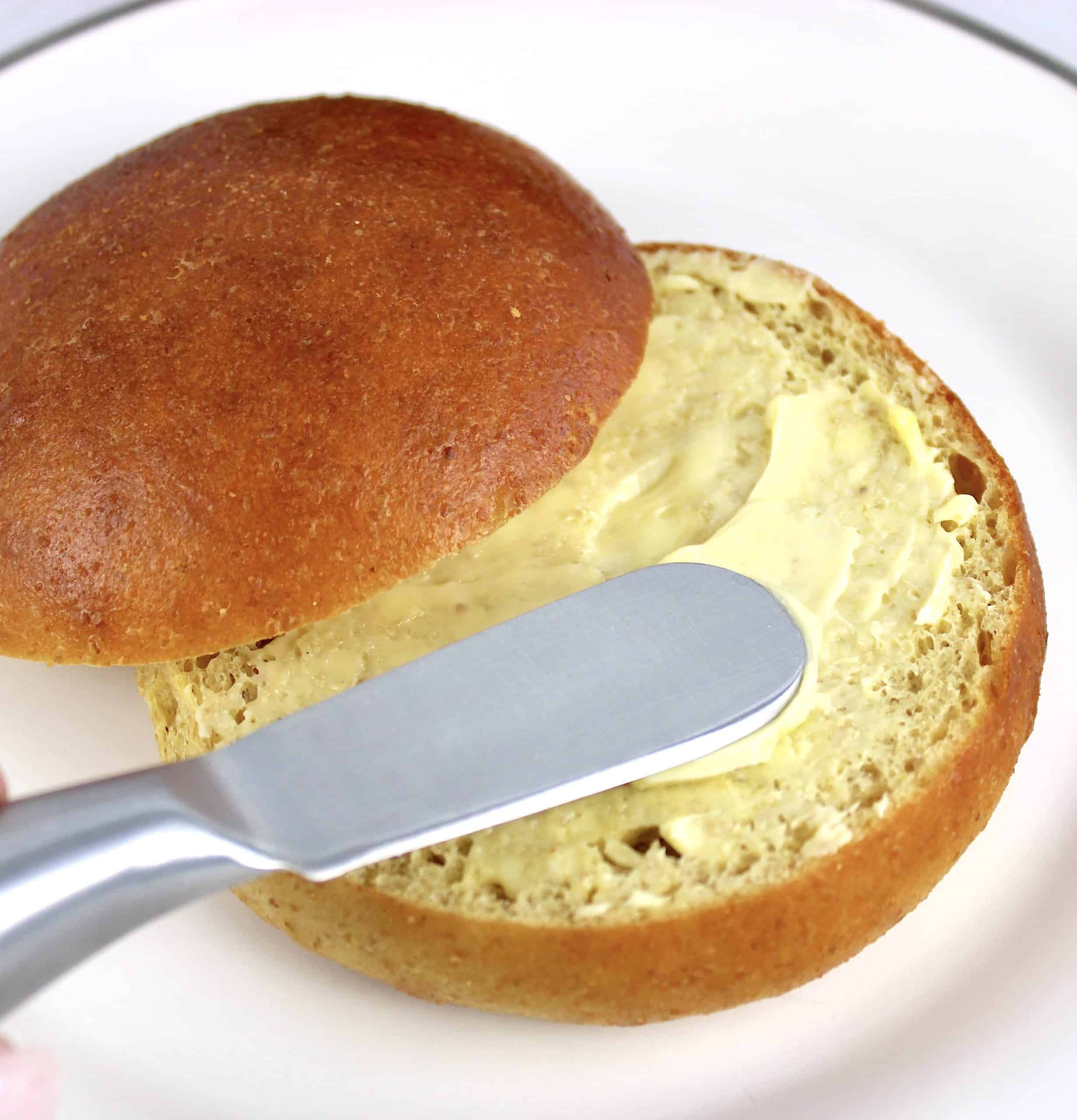
Does Keto Bread Have Carbs?
When considering the carbs in any food, Keto bread included, take the total carbs, subtract the fiber (and any sugar alcohol if it has any) and you’re left with the amount of net carbs. Fiber plays a huge part in how you determine if a particular bread is Keto friendly.
On Keto you drop your carb intake in order to minimize glycogen stores and to train the body to burn fat for fuel. Fiber is a carb, but because it is not a source of energy the body uses, you do not count fiber as a carb.
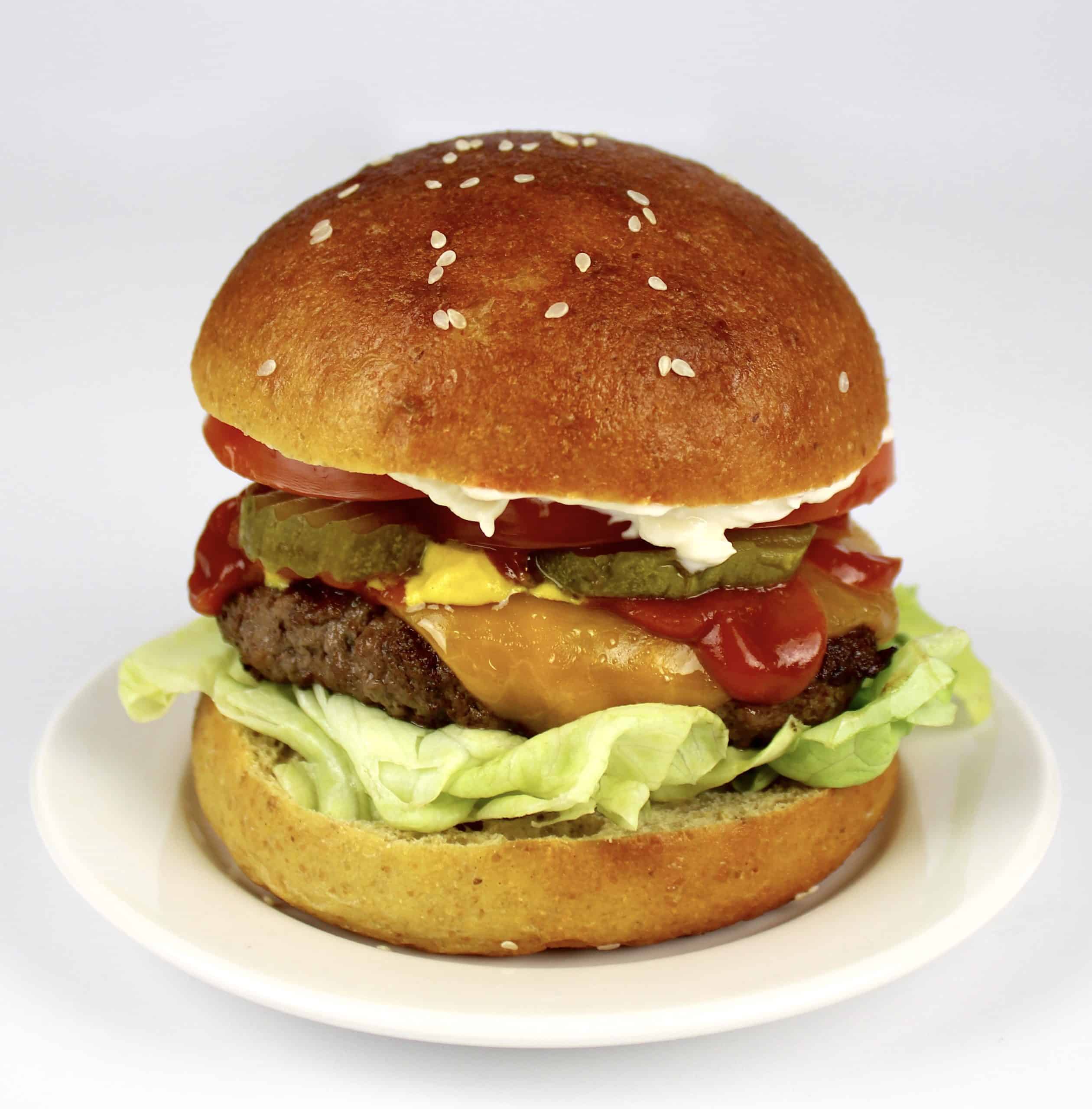
More Keto Bread Recipes
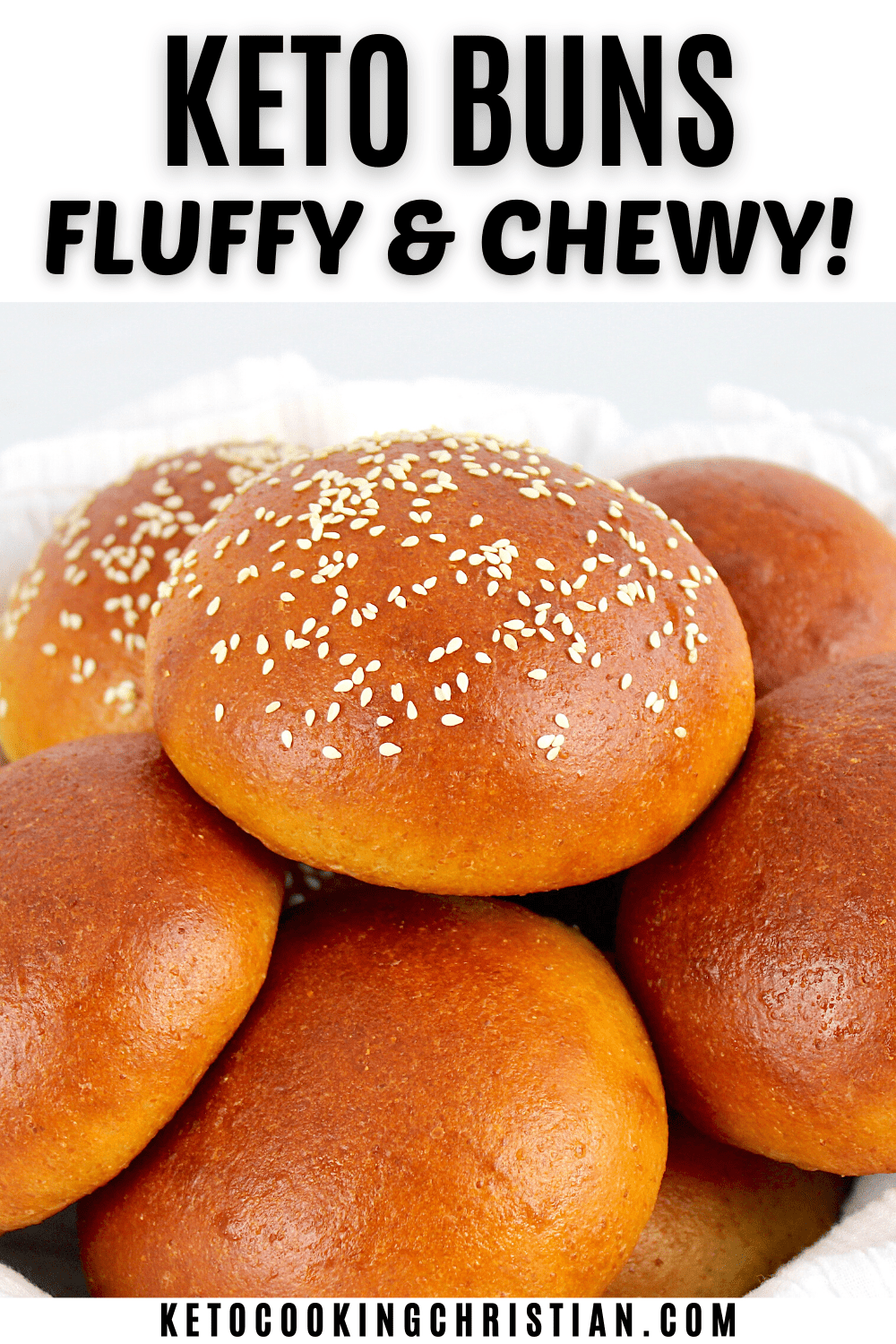
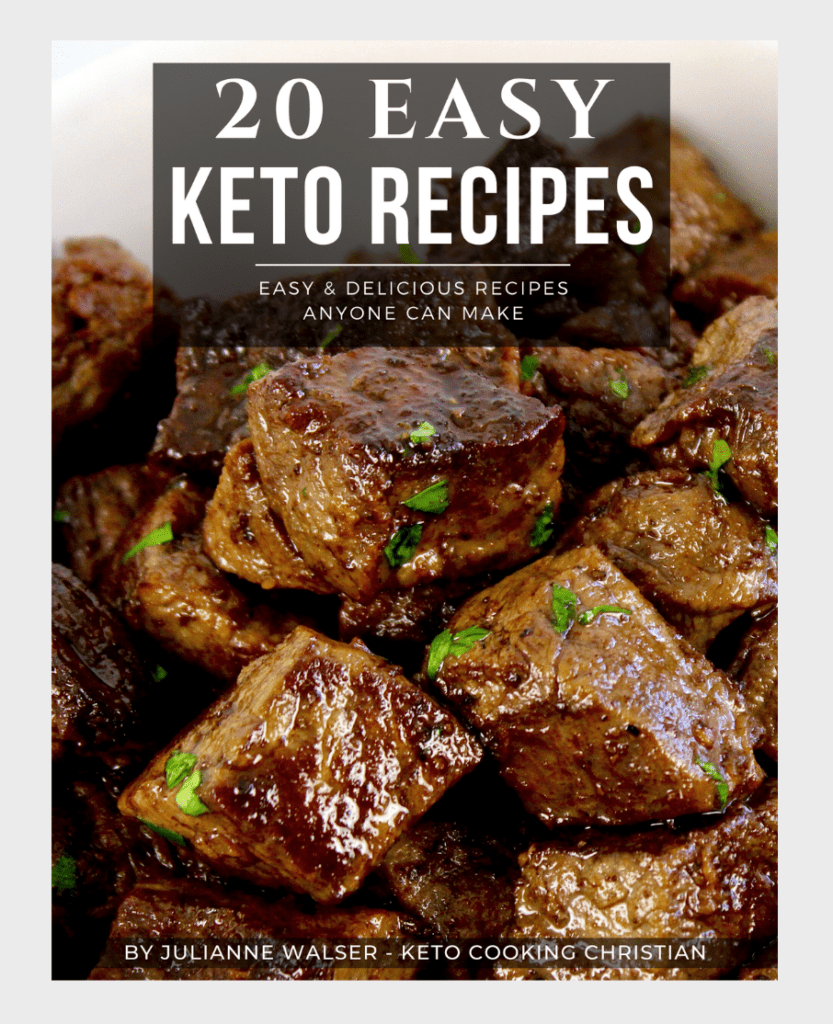
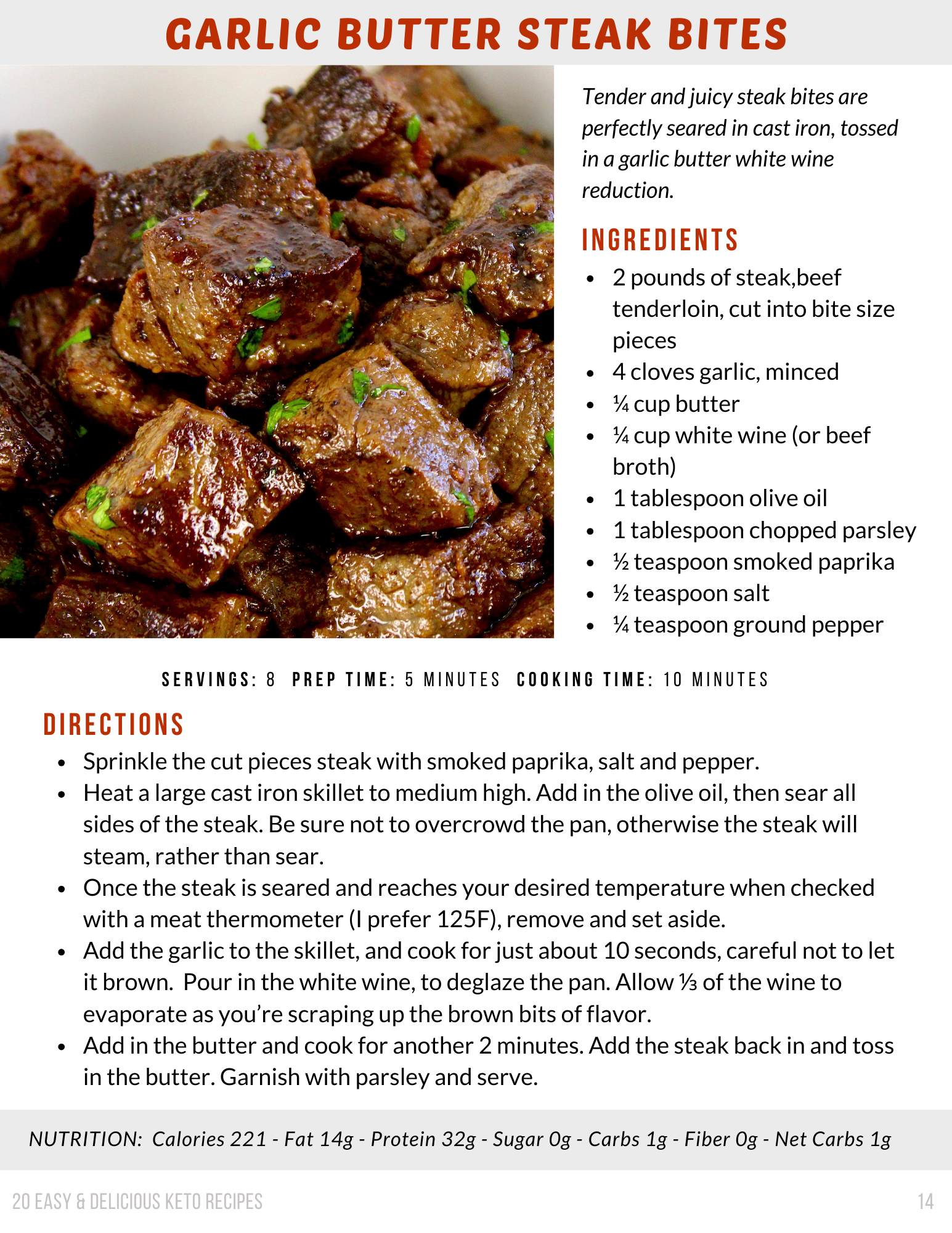
Download FREE COPY OF
20 Easy Keto Dinners eBook
Easy and delicious Keto recipes that anyone can make!

Homemade Keto Buns (Fluffy and Chewy)
Ingredients
- 1 1/4 cups vital wheat gluten, (see recipe notes in post)
- 1/2 cup oat fiber
- 1/3 cup lupin flour, (save 20% with code: KETOCC20)
- 1/3 cup ground golden flax seed, + 1-2 TBSP
- 1 cup warm water, about 125°F
- 2 whole eggs, beaten and room temperature
- 3 tablespoons monk fruit/allulose
- 2 tablespoons butter, softened
- 1 tablespoon active dry yeast
- 2 teaspoons baking powder
- 1 teaspoon inulin powder, to activate the yeast
- 1 teaspoon salt
Instructions
- Add the warm water and inulin into a mixing cup, then sprinkle the yeast over the top. Quickly mix for a few seconds, then allow the yeast to bloom while you mix up your dry ingredients. If you don’t have inulin, you can use honey instead.
- In the bowl of a stand mixer, add in the vital wheat gluten, oat fiber, lupin flour, golden flaxseed, sweetener, salt and baking powder.
- Whisk to combine, break up any lumps and make it light and fluffy.
- Once the yeast has bloomed (takes about 5-7 minutes), slowly pour it into mixer as it’s running.
- Then pour in the beaten eggs, until the dough comes together.
- Add in the butter and continue mixing, just until combined. If the dough is too sticky, sprinkle in 1-2 tablespoons of golden flaxseed, starting with just 1 tablespoon. It should be a little tacky, but not very sticky and the sides of the bowl should be fairly clean.
- Scrape down the sides, remove the paddle, then replace with a dough hook. Allow the dough to knead for 7 minutes.
- Let the dough rest for 10 minutes. I use this time to clean up a little and prepare my pan.
- Once the dough has rested, turn it out onto your board, I use my Silpat because it doesn’t slide around. Cut the dough into 8 portions, and I prefer to weigh them, so I know they’re all around the same size and will cook at the same time.
- Take each piece and flatten it out slightly, then pull all the edges into the center, creating a ball. Pinch all the seams together and turn over.
- Cupping your hand over the top, roll the dough in a circular motion until the seam has closed and is no longer showing.
- Place the buns on a baking sheet lined with parchment paper, then sprayed with nonstick spray or olive oil.
- Spray a piece of plastic wrap with nonstick spray and gently place on top of the buns, don’t tuck in the ends or wrap it tight. You want to give it plenty of room to expand.
- Using the bread proof setting in your oven, allow to proof for 2 hours. To help create the perfectly warm moist environment, place a shallow pan with boiling water on the bottom of your oven. If your oven doesn’t have a bread proof setting, you can place a microwave safe dish or glass with hot water in the microwave, along with the rolls to proof in there.
- It’s important that they rise in a very warm and preferably moist environment if possible. Rise times can vary based on your temperature and elevation.
- Preheat oven to 350°F. Remove the plastic wrap and bake the buns 18-20 minutes or until golden brown and cooked through.
- Allow the buns to cool on a cooling rack before serving. Store leftovers at room temperature for 1-2 days, then store in the fridge in an airtight container for 3-4 days. You can also freeze them!
Recipe Notes
*Make sure to scroll up and read the post for substitutions, additions and helpful tips for making this recipe.
*Nutritional data is provided as a courtesy and is accurate to the best of my knowledge. You can verify it using the nutrition calculator of your choice. All data is based on net carbs, without sugar alcohol: Swerve, Erythritol, Monk Fruit or Allulose.
© Copyright for Keto Cooking Christian LLC. Please use the share buttons to share on social media, but please do not copy/paste the recipe.
Rate this Recipe
Do I need to go by the standard or metric measurement because they are not the same. I was in the middle of making these when I decided to measure and weigh. Please respond.
I would go by the standard US measurements to be absolutely sure, that’s what I use and they turn out perfect every time.
THANK YOU SO MUCH! I could hug you! LOL.
How sweet, you’re so welcome. I hope you enjoy them!
what can be substituted for the gluten?
For this recipe, I’m sorry but I have not tried making it with any substitutions.
Can you tell me how to get a crispier top for this recipe Thank you Love most of the recipes of yours that I have tried Am still looking for a more real bread/bun recipe I grew up eating rye bread and most Keto breads remind me of white bread
This recipe makes buns that have the same fluffy and chewy texture of traditional buns. Have you tried toasting them to make the tops crispy?
I was so excited to see you have a keto bun recipe … until I saw it contains vital wheat gluten. I cannot have any gluten so unfortunately I cannot try these. I will wait (patiently) for more of your bread recipes to come out, as I know they will be fabulous like all your recipes are. Thank you for all you do! I love your recipes!
Thank you and you’re so welcome. I am so happy to hear that you are enjoying my other recipes.
These are the best Keto buns I have had! I have made many recipes and either they are too eggy, too cheesy or too heavy with wheat flavor! These taste great and are well balanced, nice and soft and don’t fall apart. They are perfect for Hamburgers, BBQ sandwiches, etc. My new favorite recipe. Thank you for this recipe!
I’m so glad you loved them! I really do as well, they have such wonderful texture and flavor.